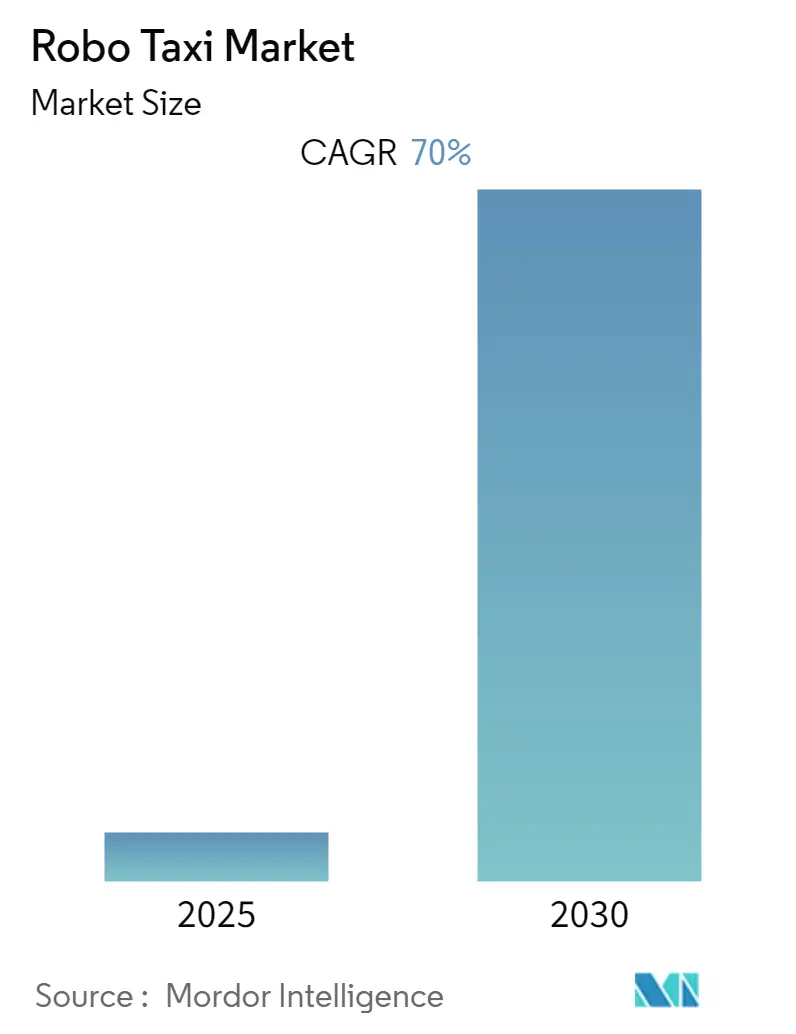
Mordor Intelligence has published a new report on the Robo Taxi Market, offering a comprehensive analysis of trends, growth drivers, and future projections.
The Robo Taxi Market is projected to grow at a CAGR of 70% during the forecast period. Advancements in advanced driver assistance systems (ADAS) and an increasing focus on multifunctional vehicle systems are creating significant opportunities for industry players to develop and expand autonomous vehicle technologies.
Key Trends
- Technological Advancements in Autonomous DrivingThe integration of sophisticated ADAS and artificial intelligence (AI) is accelerating the deployment of robo-taxis. Companies are investing heavily in sensor technologies, machine learning algorithms, and real-time data processing to enhance vehicle autonomy. For instance, the development of Level 4 and Level 5 autonomous vehicles, capable of performing all driving functions under specified conditions without human intervention, is gaining momentum.
- Growing Emphasis on Sustainable Urban MobilityUrban centers worldwide are grappling with traffic congestion and environmental concerns. Robo-taxis, particularly those powered by electric propulsion systems, offer a sustainable alternative by reducing emissions and optimizing traffic flow. The shift towards zero-emission vehicles aligns with global efforts to combat climate change and promote sustainable urban development.
- Strategic Collaborations and PartnershipsIndustry leaders are forming strategic alliances to expedite the development and deployment of robo-taxis. Collaborations between automotive manufacturers, technology firms, and ride-hailing companies are fostering innovation and facilitating large-scale testing and implementation of autonomous ride-sharing services. For example, partnerships between companies like Waymo and Uber aim to leverage combined expertise to advance robo-taxi technologies.
Market Segmentation
The robo-taxi market is segmented based on the level of autonomy, propulsion type, vehicle type, application, service type, and geography:
- By Level of Autonomy:
- Level 4: Vehicles capable of performing all driving functions under specific conditions, with human intervention optional.
- Level 5: Fully autonomous vehicles with no human intervention required under any conditions.
- By Propulsion Type:
- Electric Vehicles (EVs): Robo-taxis powered solely by electric batteries.
- Hybrid Vehicles: Combining internal combustion engines with electric propulsion.
- Fuel Cell Electric Vehicles (FCEVs): Utilizing hydrogen fuel cells to generate electricity for propulsion.
- By Vehicle Type:
- Car: Standard passenger vehicles adapted for autonomous operation.
- Van/Shuttle: Larger vehicles designed for group transportation in urban settings.
- By Application:
- Passenger Transportation: Providing autonomous ride-hailing services for individuals.
- Goods Transportation: Utilizing autonomous vehicles for logistics and delivery services.
- By Service Type:
- Rental-Based: On-demand autonomous vehicle services without fixed routes.
- Station-Based: Autonomous services operating between designated stations or hubs.
- By Geography:
- North America: Significant adoption driven by technological advancements and supportive regulatory frameworks.
- Europe: Emphasis on sustainable urban mobility and stringent emission regulations fostering growth.
- Asia-Pacific: Rapid urbanization and government initiatives promoting autonomous vehicle development.
- Rest of the World: Emerging interest in autonomous solutions for transportation challenges.
Get a Customized Report Tailored to Your Requirements: https://www.mordorintelligence.com/market-analysis/autonomous-taxi
Key Players
The robo-taxi market features prominent players driving innovation and deployment:
- Waymo LLC: A subsidiary of Alphabet Inc., Waymo is a pioneer in autonomous driving technology, operating extensive testing programs and launching commercial robo-taxi services in select regions.
- Uber Technologies Inc.: Leveraging its ride-hailing platform, Uber is investing in autonomous vehicle research to integrate robo-taxis into its service offerings.
- Navya SA: Specializing in autonomous shuttles, Navya focuses on providing driverless solutions for urban transportation and has deployed vehicles in various cities globally.
- AutoX Inc.: A Chinese startup emphasizing AI-driven autonomous driving solutions, AutoX has initiated robo-taxi pilot programs in multiple urban centers.
- Tesla Inc.: Known for its electric vehicles, Tesla is advancing its Full Self-Driving (FSD) technology, aiming to enable its vehicles to operate as autonomous robo-taxis in the future.
Conclusion
The global robo-taxi market is on the cusp of a transformative expansion, driven by technological innovations, environmental imperatives, and evolving urban mobility needs. As key industry players continue to develop and deploy autonomous driving technologies, robo-taxis are set to become integral to the future of transportation, offering safe, efficient, and sustainable mobility solutions.
Industry Related Reports
Taxi Market: The report provides Global Taxi Market Statistics and is segmented by Booking Type (Online Booking and Offline Booking), Vehicle Type (Motorcycles, Cars, and Other Vehicle Types such as Vans), Service Type (Ride-Hailing and Ride-Sharing), and Geography (North America, Europe, Asia-Pacific, and the Rest of the World).
Middle-East and North Africa Taxi Market: The report examines the Middle East & North Africa Taxi Market Growth and is segmented by Booking Type (Online Booking and Offline Booking), Vehicle Type (Budget Car and Luxury Car), Service Type (Ride-Hailing and Ride-Sharing), and Country (Egypt, Morocco, Qatar, United Arab Emirates, Saudi Arabia, Israel, and the Rest of the Middle East and North Africa).
